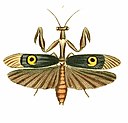File:Illustrations of Exotic Entomology III 43.jpg
Jump to navigation
Jump to search

Size of this preview: 468 × 599 pixels. Other resolutions: 187 × 240 pixels | 375 × 480 pixels | 600 × 768 pixels | 800 × 1,024 pixels | 1,933 × 2,473 pixels.
Original file (1,933 × 2,473 pixels, file size: 324 KB, MIME type: image/jpeg)
File history
Click on a date/time to view the file as it appeared at that time.
| Date/Time | Thumbnail | Dimensions | User | Comment | |
|---|---|---|---|---|---|
| current | 16:14, 30 November 2014 |  | 1,933 × 2,473 (324 KB) | Keith Edkins | {{Information |Description={{en|1=Plate XLIV. 1. MANTIS (HARPAX) OCELLARIA (= ''Pseudocreobotra ocellata''). 2. PENTATOMA BICOLORATA (= ''Platynopiellus septemdecimmaculatus''). 3. CERBUS? FLAVEOLUS (= ''Cossutia flaveola''). 4. DIASPIDIUS SCAPHA.... |
File usage
The following page uses this file:
